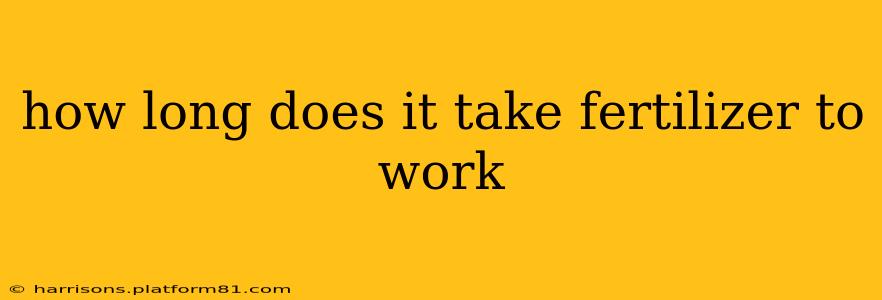Knowing how long it takes fertilizer to work is crucial for successful gardening and lawn care. The answer, however, isn't a simple number. The timeframe depends on several interacting factors, making it a complex process. This guide will delve into these factors, providing you with a comprehensive understanding of fertilizer efficacy and timing.
What Type of Fertilizer Are You Using?
Different fertilizers release nutrients at different rates. This is a critical factor affecting how quickly you'll see results.
-
Fast-Release Fertilizers: These are readily available to plants, providing a quick boost of nutrients. You'll often notice results within a week or two, evident in greener leaves and faster growth. However, this rapid release also means the nutrients are quickly depleted, requiring more frequent applications. Examples include water-soluble fertilizers and some granular blends.
-
Slow-Release Fertilizers: These fertilizers release nutrients gradually over weeks or even months. This sustained release provides a more consistent supply of nutrients, reducing the need for frequent applications. You might not see immediate dramatic changes, but the long-term benefits are significant, including healthier plants and improved soil health. Examples include coated fertilizers and organic fertilizers like composted manure.
-
Organic Fertilizers: Compost, manure, and other organic materials break down slowly, releasing nutrients over a longer period. The exact timeframe depends on the material and environmental conditions, but it's typically measured in months, offering a sustained, gentle nourishment for plants.
What Are the Environmental Conditions?
Environmental factors significantly influence how quickly fertilizer works:
-
Temperature: Warmer temperatures accelerate the decomposition of organic fertilizers and the uptake of nutrients by plants. Cooler temperatures slow down these processes.
-
Moisture: Sufficient soil moisture is crucial for nutrient availability and uptake. Dry conditions can hinder fertilizer effectiveness, while excessive moisture can leach nutrients away.
-
Soil Type: Different soil types have varying nutrient-holding capacities and drainage characteristics. Sandy soils tend to drain quickly, potentially leading to nutrient loss if not managed properly. Clay soils can hold nutrients well but may release them slowly.
What Plant Are You Fertilizing?
Plants have different nutrient needs and uptake rates. Fast-growing plants will often respond more quickly to fertilization than slow-growing ones.
How Much Fertilizer Did You Use?
Applying too little fertilizer will yield minimal results, while applying too much can harm plants through nutrient burn or imbalance. Always follow the instructions on the fertilizer packaging carefully.
How is the Fertilizer Applied?
The method of application impacts how quickly the nutrients become available to plants. Liquid fertilizers applied directly to the soil or foliage often show faster results than granular fertilizers that need to be dissolved and absorbed.
How Soon Will I See Results? (Addressing a common PAA question)
The time it takes to see results varies greatly, depending on the factors mentioned above. With fast-release fertilizers under ideal conditions, you might see visible changes within a week or two. With slow-release or organic fertilizers, it could take several weeks or even months to see noticeable improvements. Patience is key, especially when using slow-release options. Focus on consistent care and appropriate application rather than expecting immediate dramatic transformations.
What if My Fertilizer Isn't Working? (Another frequent PAA question)
If you're not seeing results after a reasonable amount of time (considering the type of fertilizer used and environmental conditions), several factors might be at play:
- Incorrect application: Ensure you are following the instructions on the fertilizer package accurately.
- Soil pH imbalance: A soil test can help determine if your soil pH is preventing nutrient uptake.
- Nutrient deficiencies other than those addressed by the fertilizer: You might need a different fertilizer blend to address specific plant needs.
- Pest or disease problems: Plant health issues can overshadow the effects of fertilizer.
- Environmental stress: Extreme temperatures, drought, or excessive moisture can hinder plant growth despite fertilization.
By understanding these factors, you can better anticipate how long it will take your fertilizer to work and tailor your approach for optimal results. Remember that consistent, proper fertilization is a crucial component of healthy plant growth, but it's just one piece of the puzzle. Good soil health, proper watering, and pest management are equally important.
